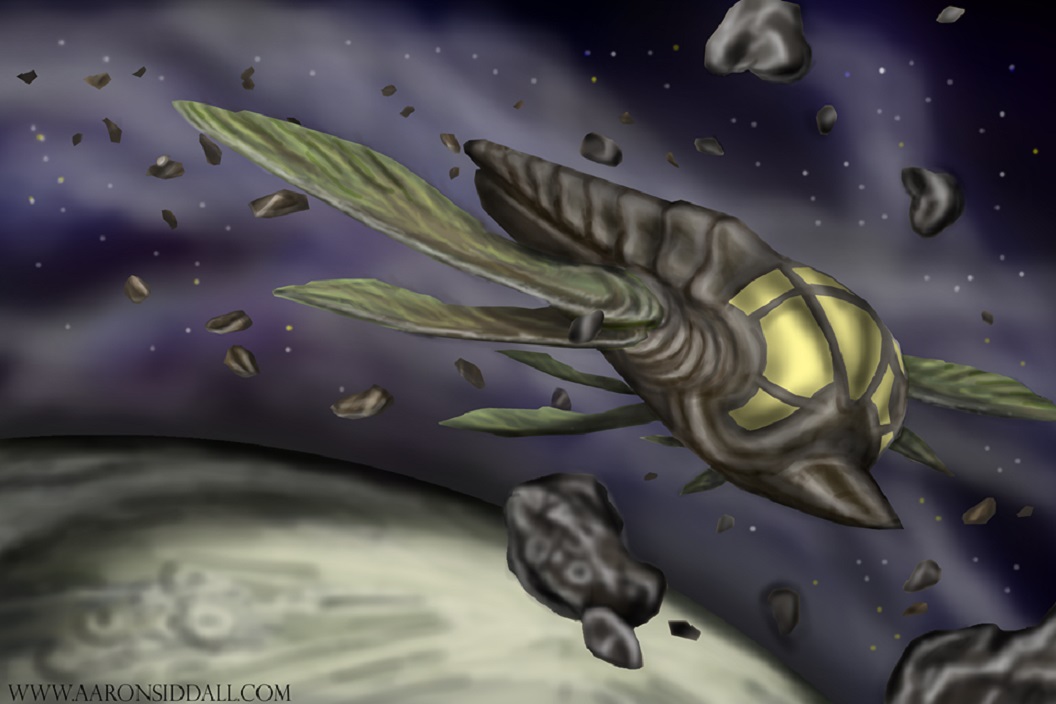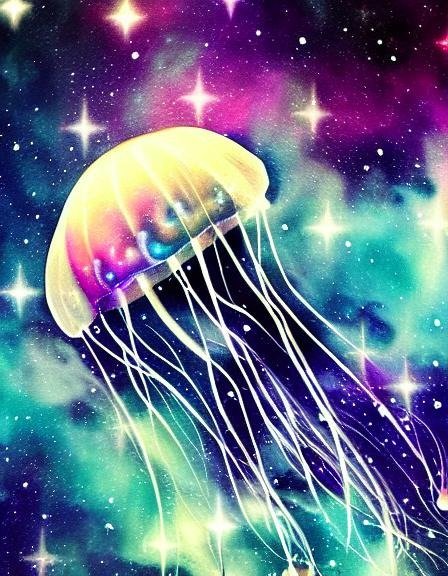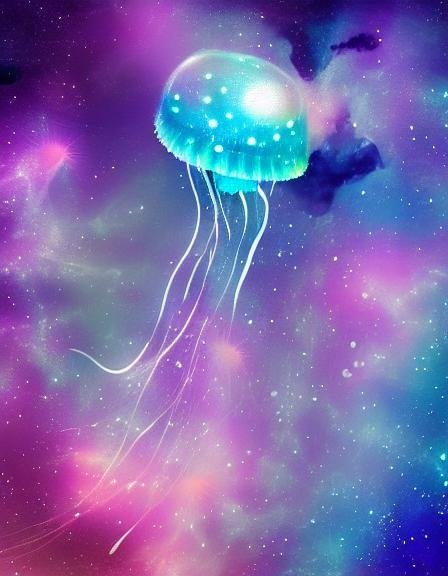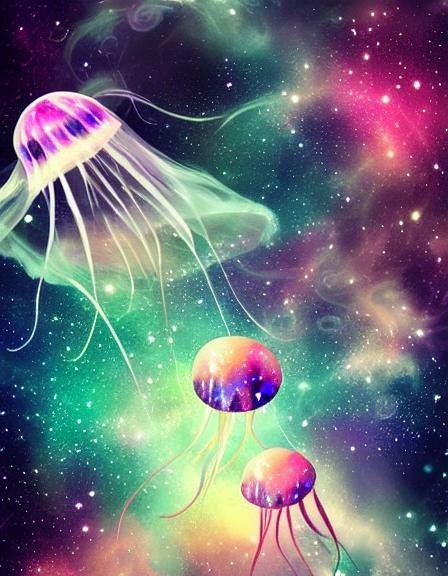Star-Jelly
Star-jellies are extraterrestrial creatures with a superficial resemblance to marine jellyfish. They have umbrella-shaped bells for bodies and trailing tentacles. The bell can pulsate to provide propulsion for highly efficient locomotion, releasing spurts of gas to create thrust. The tentacles are armed with stinging cells and may be used to capture prey and defend against predators. They are large creatures that can vary from the size of a gunboat to the size of a corvette, and with their colourful, translucent bodies, they pose a hazard to spacefarers in nebulae, their preferred habitat.
Basic Information
Anatomy
The main feature of a star-jelly is the umbrella-shaped bell. This is a hollow structure consisting of a mass of transparent jelly-like matter, which forms the hydrostatic skeleton of the creature. 95% or more of the "jelly" consists of water, but it also contains collagen and other fibrous proteins, as well as wandering mobile cells called amoebocytes which can engulf debris and bacteria. The "jelly" is bordered by the epidermis on the outside and the gastrodermis on the inside. The edge of the bell is divided into rounded lobes (lappets), which allow the bell to flex. In the gaps or niches between the lappets are dangling rudimentary sense organs called rhopalia, and the margin of the bell streams tentacles.
On the underside of the bell is a stalk-like structure hanging down from the centre called the manubrium, with the mouth, which also functions as the anus, at its tip. Four oral arms are connected to the manubrium, streaming away into the water below. The mouth opens into the gastrovascular cavity, where digestion takes place and nutrients are absorbed. This is subdivided by a central stomach and four gastric pockets. The four pairs of gonads are attached to the septa that separate these pockets, and close to them four septal funnels open to the exterior, oxygenating the gonads.
Near the free edges of the septa, gastric filaments extend into the gastric cavity; these are coated with stinging organelles and enzyme-producing cells and play a role in subduing and digesting the prey. The gastric cavity is joined to radial canals which branch extensively and connect to a marginal ring canal. Cilia in these canals circulate the fluid "jelly" and gasses in a regular direction.
The tentacles of a star-jelly are armed with potent stinging cells called nematocysts. Contact with a jelly tentacle can trigger millions of nematocysts to pierce the skin and inject venom. The effects of stings range from mild discomfort to extreme pain and death. Stings may cause anaphylaxis (a form of shock), which can be fatal.
The difficulty in treating star-jelly stings is, first of all, the sheer number of them when encountering such a large creature, such as when an unwitting ship flies directly through one. The other difficulty is that nematocysts often remain in the sting site, like thorns or nettles, and will often release more venom if pierced or disturbed. Scraping the sting site free of nematocysts is advised before rubbing on any soothing ointments to reduce pain or itching, but clerics often have prayers that will neutralize the venom.
The bodies of star-jellies show starlike patterns of bioluminescence, which are typically most visible in a spawning group.
Genetics and Reproduction
Upon reaching adult size, star-jellies spawn regularly if there is a sufficient supply of food. Spawning is controlled by proximity to a star, and is triggered by solar flares. The bioluminscence of star-jellies is most visible when a spawning is about to begin, as it is believed they illuminate themselves in order to draw the attention of other star-jellies. Jellies are usually either male or female (with occasional hermaphrodites). Adults release sperm and eggs into the surrounding space, where the unprotected eggs are fertilized and develop into larvae.
Rooting polyps may also appear in "star-jelly blooms" when conditions are particularly suited to their reproduction at that stage.
Growth Rate & Stages
Star-jelly life cycles are complex. They begin life larvae called planulae, which are covered with cilia. When sufficiently developed, they settle onto a firm surface, such as an asteroid, a ship hull, a Star Tortoise shell, or even free-floating plant-life, and develop into a polyp.
The polyp is a stalk topped by a mouth that is ringed by upward-facing tentacles. It will usually settle in a colony of other polyps, since suitable surfaces are hard to find in the Void. The polyp feeds continually and this stage may last for years.
After an interval and stimulated by seasonal or hormonal changes, the polyp may begin reproducing asexually by budding, becoming a segmenting polyp. Budding produces more segmented polyps and also ephyrae, which are a pre-adult, detached, free-floating form. It grows and develops, gaining its distinctive tentacles, until it reaches the adult medusa stage, which is what is typically identified as a star-jelly.
Ecology and Habitats
Star-jellies almost exclusively inhabit nebulae, which provide the best combination of available resources for them.
Dietary Needs and Habits
Star-jellies survive on drifting small organisms that float through the spaceways, and nutrients absorbed from the ambient gasses of nebulae. They use the radiation of nearby stars as a catalyst to process those gasses. A well-fed star-jelly is a little nebula of its own, shifting with gas clouds of different hues through its translucent skin, and displaying bioluminescent starlike patterns in its body.
Additional Information
Uses, Products & Exploitation
Star-jellies are regarded as a delicacy in some cultures.
Perception and Sensory Capabilities
The rhopalia contain rudimentary sense organs which are able to detect light, radiation, odour and orientation. A loose network of nerves called a "nerve net" is located in the epidermis. A star-jelly does not have a traditional central nervous system. Instead, it possesses a nerve net concentration and ganglion-like structures which acts in its place. A star-jelly detects stimuli, and transmits impulses both throughout the nerve net and around a circular nerve ring, to other nerve cells. The rhopalial ganglia contain pacemaker neurones which control pulsation rate and direction.
Rhopalia include ocelli, light-sensitive organs able to tell light from dark. The rhopalia are suspended on stalks with heavy crystals at one end, acting like gyroscopes to orient the eyes towards the nearest star.
Don't forget that you can click on the blue compass on the left to access the Table of Contents at any time!

Want to read all of the Toy Soldier Saga fiction, even before the rest of the world does?Subscribe now!
Scientific Name
Scyphozoa astra
Lifespan
Unknown
Conservation Status
There is no ongoing conservation effort for this species.
Geographic Distribution







I love the idea of space jellies. I bet they are so pretty to watch making their way through space.
Hey Emily, thanks! Yeah, I take the "space is an ocean" trope to the extreme and I have a lot of analogs of marine life. I think they'd be amazing to watch too (but from a safe distance!)